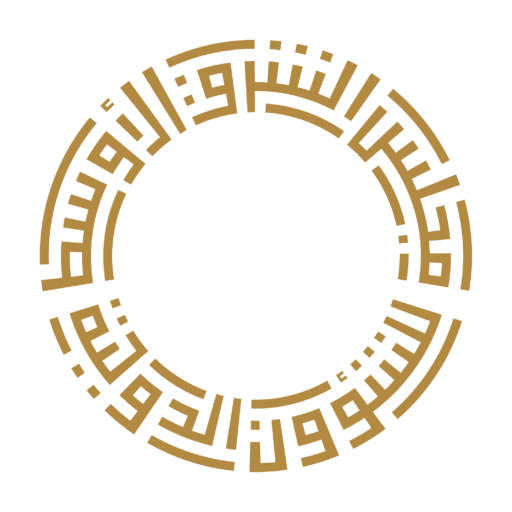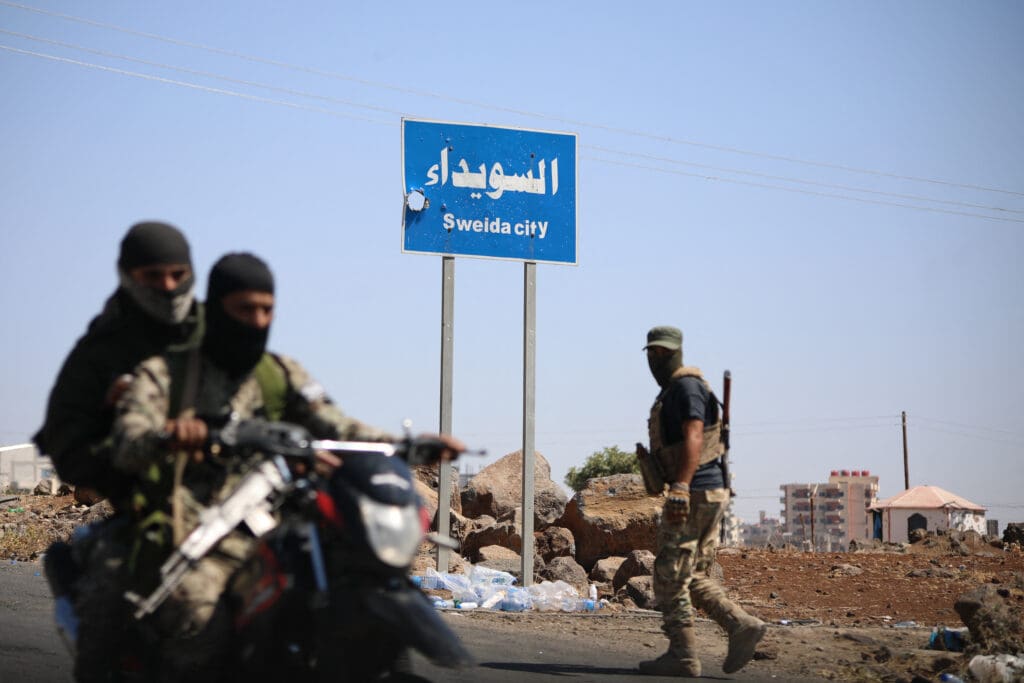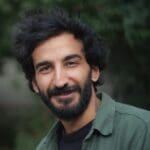The recent violence in Syria’s Sweida province has presented the caretaker government with the strongest challenge to its authority and legitimacy since the fall of the Assad regime in December.
It began with an act of petty crime, when a Bedouin gang allegedly robbed a Druze merchant. This in itself was not unprecedented; Sweida’s Bedouin and Druze gangs had committed multiple acts of robbery and violence against each other over the past decade.
The subsequent conflict, however, set a new precedent for the violence, as over 1,100 Syrians were killed and up to 93,000 displaced. Meanwhile, the tentative détente between Israel and Syria lies in ruins. In an unprecedented intervention, Israel’s air force killed scores of the government’s General Security Services (GSS) in Sweida and then escalated further to bomb government buildings in Damascus.
In many ways, this looks like a grisly repeat of the violence in Syria’s coastal regions in March 2025, where pro-government militias killed at least 1,426 mainly-Alawite victims. In both cases, localized clashes quickly took on a life of their own, dragging in multiple actors before descending into sectarian killings that caused horror within and beyond Syria.
In Latakia and Sweida alike, it was Damascus’s inability to project authority that led to a local power vacuum, which sectarian militias soon filled. In March, pro-Assad remnants overwhelmed the rump GSS presence in Latakia. Damascus issued a call for help, which around 200,000 fighters from across Syria answered. This was a heterogenous group spanning GSS forces and a plethora of other militias. In July, after GSS forces withdrew from Sweida following Israeli strikes, it was Bedouin militias who filled the void. It remains unclear whether the Bedouin groups were following orders from Damascus; that they arrived in military convoys from all over the country suggests at least a degree of coordination.
In neither case could Damascus stop these groups—who operated outside the government’s control—from launching sectarian reprisals against local Alawites and Druze.
These tragic episodes illustrate why Syria needs a strong and functioning central government. Latakia and Sweida were largely autonomous—a hangover from the civil war, when the overstretched Assad regime found itself lacking the capacity to govern the country. Accordingly, it devolved authority to local notables, who declared loyalty to the regime, while largely avoiding the worst of Assad’s totalitarian excesses.
That the violence in Sweida began with a robbery illustrates that this system worked, until it did not. Rather than turn to the state, the Druze victim relied on militias from within his own ethno-religious group to pursue justice. The result was a series of tit-for-tat killings that ended in widespread communal violence. Likewise in March, had Latakia had a sufficiently numerous and well-embedded GSS garrison, Damascus might have avoided having to rely on extra-governmental militias to confront the challenge to its authority. As both these cases demonstrated, without disciplined personnel under central command, the decision to escalate and use force often has dire consequences. It is not just the victims of the violence who pay the price; Syria’s government loses credibility, sectarian tension is exacerbated and the country’s political transition is set back.
But any strong central government must also be inclusive. This is as much from pragmatic necessity as a desired normative end-state. Damascus does not have enough troops to rule through coercion alone. It must therefore catch more flies with honey than with vinegar, by forging a state that most of Syria’s citizens perceive to be legitimate and aligned with their own interests. This is why the government was right to publish the findings of its commission of enquiry into the March massacres in full, albeit after a three-month delay. But while the commission provided a tally of the victims, it did not name the perpetrators. It also downplayed the systemic nature of the killings by deeming them “unorganized.”
The government’s conduct in Sweida suggests that its actions will continue to fall short when it comes to creating legitimacy through transparency and inclusivity. This is because Damascus not only lacks authority over its rivals, but its own forces, too.
This was even more evident in July than in March. In the latter case, the government could claim that the worst offenders were militias outside its control. By July though, this excuse wore thin; Bedouin militias did commit atrocities after the security forces withdrew from Sweida, but the emerging evidence suggests that the GSS were the worst offenders.
To Syria’s minorities, then, the state and its security forces look increasingly like everything they claim not to be—a Sunni Arab mob in institutional garb. Thankfully, there is no credible evidence that the government ordered the atrocities. But Al-Sharaa’s condemnation of these acts does not sit well with a worrying trend: Whenever there have been large-scale GSS deployments, Syrians can expect abuses of power and sectarian killings. This only exacerbates existing fears that the government’s security forces are nothing but a re-badged Hayut Tahrir al-Shams, the former violent Jihadist group that now holds de facto power in Syria.
Adding fuel to this tinderbox, on July 18, a pro-government mob that included at least one uniformed police officer attacked a peaceful anti-violence protest. That this was in Damascus illustrates that the events in Sweida will reverberate beyond the province itself. Despite taking place outside the parliament, which remains vacant of deputies due to the delay in their appointments, the government was unable or unwilling to confront this latest challenge to its claim to govern, in Sharaa’s words, “for all Syrians.” Equally, that Sharaa publicly praised the Bedouin tribes who deployed to Sweida will likely only exacerbate tensions with the country’s Druze, who feel increasingly under siege.
This is not just a capacity or governance issue, it is a national security issue. Syria is a country with too many guns and militias. Accordingly, Damascus has rightly sought to disarm the country’s multiple militias or integrate them under government control.
Yet on this front, it has also fallen short. Many militias have “reflagged,” proclaiming loyalty to the government while retaining their old command and control structures. Equally, several former militia leaders whom al-Sharaa made generals, such as Mohammad Jaseem, are under foreign sanctions for their role in the coastal massacres in March 2025.
The GSS’s subsequent actions in Sweida have made even a superficial integration of the province’s Druze militias more difficult. Several who were negotiating with the government have now turned against and fought the GSS. It is unlikely that these groups will now be more likely to disband. If the government’s show of force in Sweida was supposed to induce this outcome, as some commentators have argued, it could well have the opposite effect.
This will have dire implications elsewhere. In March, al-Sharaa announced that he had secured an agreement with the Kurdish-led Syrian Democratic Forces (SDF), where the latter would integrate the approximately one-third of the country it controls into central government administration. Despite the initial jubilation, though, the talks soon stalled. The SDF’s hardliners can now argue that the events in Sweida and the GSS’s war crimes vindicate their unwillingness to disarm or share power. Indeed, if the government cannot exercise sovereignty within the parts of Syria it supposedly already controls, how can it credibly claim to be willing and able to add so much more territory and people into its remit?
The events in Sweida have also set the stage for further external inference. Israel used the violence in Latakia in March to vindicate its force-centric approach vis-à-vis Syria’s new government. Similarly, as the scale of the violence in Sweida became clear, Israel argued that its intervention stopped the GSS from massacring the Druze on a similar scale to the Alawites.
On the contrary, Israel’s actions made a bad situation worse. Not only did its strikes kill GSS personnel; Israel’s claim to defend the Druze has fueled false but increasingly prominent Sunni fears that this community constitutes a fifth column. Israel’s attacks on government buildings in Damascus, in turn, make al-Sharaa’s administration look like a paper tiger. That Israeli airstrikes made the GSS turn tail and withdraw from Sweida only reinforces the image of a government that exerts de jure but not de facto sovereignty. Just as Assad surrendered Syria’s skies to Russian control, al-Sharaa was left powerless as Israel did the same.
The result is that Syria’s government will find it harder to alleviate its chronic weakness and persuade or strong-arm the country’s militias to fold or integrate, which is exactly what caused the eruptions of violence in March and July. Chaos, then, may well follow chaos. This is Israel’s stated objective in Syria—Israeli Finance Minister Bezalel Smotrich has openly called for the country to be “dismantled”—and the real reason for its near-incessant and increasingly deadly interventions within the country since December 2024.
To extricate itself from a feedback loop of institutional weakness, sectarian distrust and, ultimately, state failure, Damascus must build strength while cultivating its legitimacy among all the country’s ethno-religious groups. The violence in Latakia illustrates that the key governance issue facing Syria is not becoming a “Jihadist” state, but staying a weak one. The events in Sweida, in turn, show that employing state power without legitimacy is self-defeating. This will inevitably require a difficult balancing act. But it is the only way to build a better Syria.



